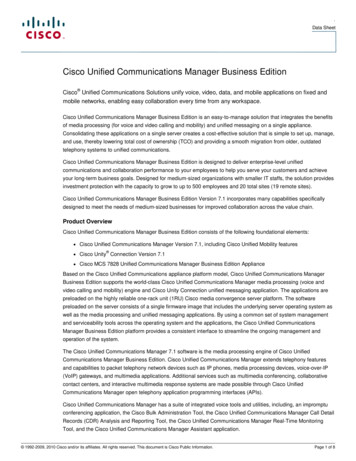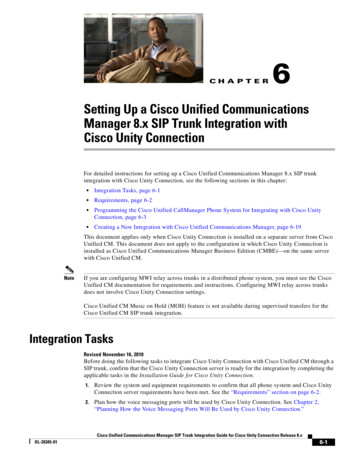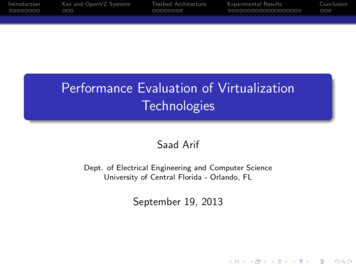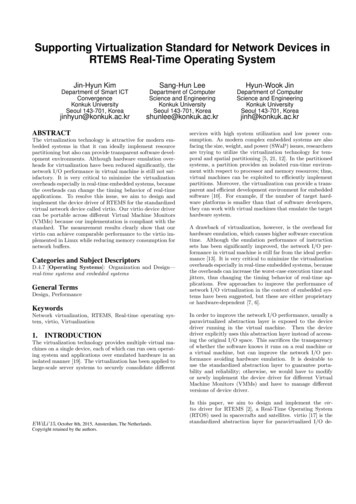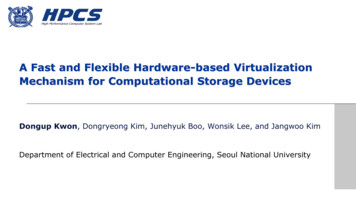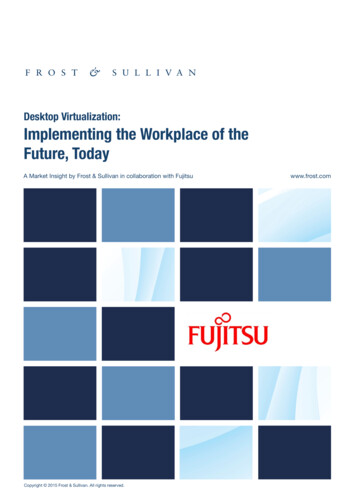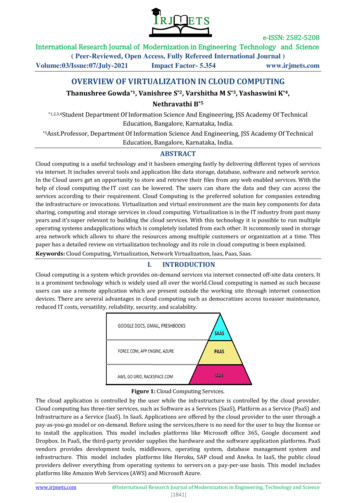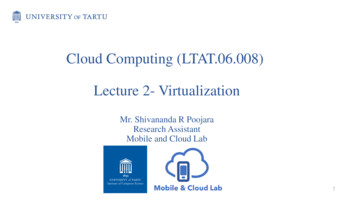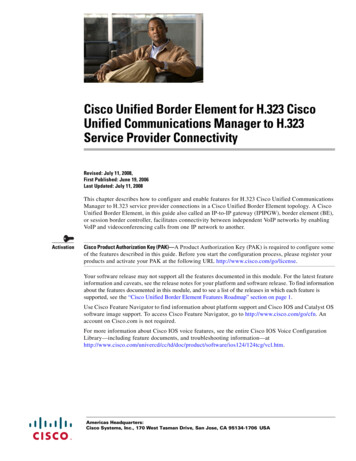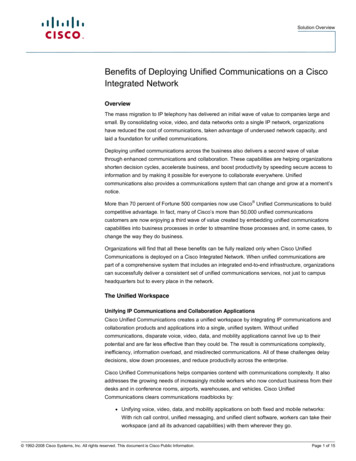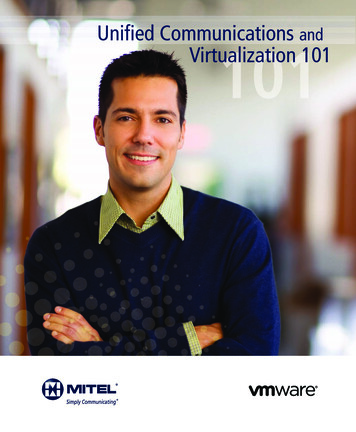
Transcription
Unified Communications andVirtualization 101
Table of Contents:What is unified communications? . 3What is unified messaging? . 3What is presence and availability? . 4What is conferencing and collaboration? . 4What is UC application integration? . 5What is VoIP? . 5What is Mitel Communications Director? . 7What is Virtual Mitel Communications Director? . 7What is Mitel Virtual Solutions? . 8What is Virtual Mitel Application Suite? . 8What is Virtual Mitel Border Gateway? . 8What is Virtual Unified Communicator Advanced? . 8What is virtualization? . 9What is a virtual machine? . 9What does “hosted” mean? . 10What does “bare metal” mean? . 10What is VMware vMotion? . 11How do I convert physical machines to virtual machines? . 12How do I manage my virtual machines? . 14How do I do load balancing and achieve HA?. 15Why virtualize voice? . 16
UNIFIED COMMUNICATIONS AND VIRTUALIZATION 101What is Unified Communications?Unified communications (UC) is the convergence of voice communications, computer networks,business applications and devices. UC at Mitel encompasses much more, including the integrationof voice, email, instant messaging, unified messaging, mobility, presence and availability,conferencing and collaboration, and application integration.This next evolution of communications changes how individuals, groups, and organizations conductbusiness. The key benefits of UC include lower communications costs, improved employee efficiencyand productivity, enhanced responsiveness to customers, suppliers and partners, and streamlinedIT management and lower total cost of ownership. Unified communications products from Mitelinclude Mitel Communications Director, Mitel Applications Suite, Mitel Border Gateway, andMitel Unified Communicator (UC) Advanced.For more info, go to:http://www.mitel.com/DocController?documentId 29559What is Unified Messaging?Unified messaging allows users to manage all forms of electronic messages including voice mail,email, and faxes through the interface that suits them best at that particular moment whether itbe a desk-phone, a mobile device, or a PC. For example, voice mail messages, can be delivered to auser’s email inbox and reviewed through a headset or speakers rather than simply via a desk-phone.Key benefits include increased user productivity and responsiveness, a lower total cost of ownership,and improved customer service levels. Unified messaging products from Mitel include UnifiedCommunicator Advanced, Mitel Applications Suite and Mitel NuPoint Unified Messaging (UM).For more info, go to:http://www.mitel.com/DocController?documentId 311813
What is Presence and Availability?Presence and availability refers to a user’s ability at any given time to show other users’ availability(or status) in real time and preferred method(s) of communication. As an integral part of unifiedcommunications applications, the user’s contacts are armed with more complete and detailedinformation prior to engaging in communications with them – e.g., are they on the phone, awayfrom their desk, or in a meeting? This degree of accessibility results in more efficient interactionswith business partners, customers, and co-workers. Presence and availability capability is includedin Mitel Unified Communicator Advanced and Mitel Applications Suite.For more info, go to:http://www.mitel.com/DocController?documentId 16380What is Conferencing and Collaboration?Conferencing and collaboration solutions provide users with an interactive, real-timeexperience that allows the same type of sharing of information and teamwork as if they wereactually face-to-face. These solutions range from simple audio conferencing, to desktop video andweb conferencing, to high definition video and document collaboration that provides an immersive“in the room” meeting experience. Conferencing and collaboration solutions enable fasterdecision-making and improve productivity within geographically dispersed work groups. Theycan be used as alternatives to business travel and keep you connected with colleagues, customers,and business partners. Conferencing and collaboration products from Mitel include Mitel UnifiedCommunicator Advanced, Mitel Audio Web Conferencing, and Mitel TeleCollaboration Solution.For more info, go to:http://www.mitel.com/DocController?documentId 95064
UNIFIED COMMUNICATIONS AND VIRTUALIZATION 101What is Unified Communications (UC) Application Integration?UC application integration embeds voice communications and conferencing and collaborationcapabilities into mission-critical business process systems and applications such as CustomerRelationship Management (CRM), Enterprise Resource Planning (ERP), and service desk operations.Integration flexibility provides users with the tools to manage and control their personalcommunications within the context of the way they do business. This creates a consistentuser experience from application to application, greatly simplifying the communicationexperience and improving worker efficiency.For more info, go to:http://www.mitel.com/DocController?documentId 24749What is VoIP?Voice over Internet Protocol (VoIP) is voice communications delivered over an IP or data networksuch as the Internet. Information is sent in digital form (packets) rather than using the traditionalcircuit-switched form. Voice packets differ from data packets in that they are generally all thesame size and they arrive in sequence. With VoIP communications systems, both voicecommunication and data transfer are over a single network – this can significantlyreduce infrastructure costs for organizations.For more info, go to:http://www.mitel.com/DocController?documentId 292195
6
UNIFIED COMMUNICATIONS AND VIRTUALIZATION 101What is Mitel Communications Director?Mitel Communications Director (MCD) call control software allows you to operate yourcommunications system with flexibility, ease, and reliability. This powerful software is the heartbeatof the UC solution running on your choice of platform such as the proprietary Mitel 3300 family ofcontrollers or industry standard servers from Sun Microsystems, HP, and IBM . MCD supports theindustry’s largest range of desktop devices and accessories, both wired and wireless, along with apowerful suite of applications including multimedia collaboration, customer relationshipmanagement, and unified messaging.For more info, go to:http://www.mitel.com/DocController?documentId 32750What is Virtual Mitel Communications Director?Virtual Mitel Communications Director (Virtual MCD) is Mitel’s first virtual appliance to runon VMware infrastructure. It offers the same MCD software deployed on the Mitel 3300, andmaintains the rich industry-leading voice communications that sets Mitel apart. The virtualappliance uses open standard definitions, enabling it to be inserted into virtualized data centersalong with other business applications. It can be deployed on any industry standard server. WithVirtual MCD, you can access the full range of telephony features including dynamic extension,clustering, resiliency support, SIP service provider interconnect, and multi-node management.For more info, go to:http://vmware.mitel.com7
What is Mitel Virtual Solutions?Mitel Virtual Solutions is a portfolio of software products that allow you to run yourUC applications in the same virtualized environment with your data applications – now youcan treat voice like any other virtualized application in the data center. In addition to Virtual MitelCommunications Director (Virtual MCD), all of the core UC applications are available includingVirtual Mitel Applications Suite (Virtual MAS), Virtual Mitel Border Gateway (Virtual MBG), andVirtual Unified Communicator (UC) Advanced (Virtual UC Advanced).What is Virtual Mitel Application Suite?Virtual MAS provides small and medium-size businesses a rich set of advanced IP applicationsincluding Mitel NuPoint Unified Messaging (UM), Mitel Speech Auto-Attendant, Mitel UnifiedCommunicator (UC) Mobile, Mitel Audio & Web Conferencing (AWC) and Mitel Teleworker Solutionvia an integration with Virtual Mitel Border Gateway. Available as a virtual appliance, this selectcombination of applications works seamlessly on a single server to improve your ability to manageinformation flow amongst customers, partners and suppliers to create a competitive advantage.What is Virtual Mitel Border Gateway?Virtual MBG, available as a virtual appliance, is a platform for the secure deployment of multiplenetwork connectivity services in a number of network edge scenarios including teleworking, allowinga secure plug and play solution for remote workers; SIP Trunk Proxy service for a SIP-aware firewallat the edge of the company network, eliminating the need for third party firewalls, and simplifyingconfiguration and deployment; and Application Web Proxy Service enabling trusted connectivitybetween the company LAN and the public internet to provide secure access for unifiedcommunication and collaboration via Virtual MAS.What is Virtual Unified Communicator Advanced?Virtual UC Advanced is a virtual appliance that integrates your communications tools in asecure and centralized system from your desktop or a mobile device. Virtual UC Advanced givesyou real-time access to everyone in the organization, on or off the premises, with user and phonepresence information that makes every phone call or instant message (IM) count, and simple waysto manage your personal communications. Employees can find, communicate, and collaborate withothers quickly, easily and in the moment.For more info, go to:http://vmware.mitel.com8
UNIFIED COMMUNICATIONS AND VIRTUALIZATION 101What is virtualization?Virtualization is software technology that makes it possible to run multiple operating systems andmultiple applications on the same computer at the same time, increasing the utilization andflexibility of hardware.For more info, go to:http://vmware.com/virtualization/What is a virtual machine?A virtual machine is a tightly isolated software container that can run its own operatingsystems and applications as if it were a physical computer. A virtual machine behaves exactlylike a physical computer and contains its own virtual (ie, software-based) CPU, RAM hard diskand network interface card (NIC).An operating system can’t tell the difference between a virtual machine and a physical machine, norcan applications or other computers on a network. Even the virtual machine thinks it is a “real”computer. Nevertheless, a virtual machine is composed entirely of software and contains nohardware components whatsoever. As a result, virtual machines offer a number of distinctadvantages over physical hardware.For more info, go ml9
What does “hosted” mean?One type of virtual environment is hosted. A hostedenvironment runs on an underlying host operating systemsuch as Windows, Linux, or Mac OSX. A virtualization layeris installed on top of the host OS and then it is possibleto create virtual machines (VMs) inside of that virtualizationlayer. Hosted products from VMware include VMware Fusion (to run Windows operating systems inside a Mac), VMware Server and VMware Workstation (to run Windows inside ofLinux or Linux inside of Windows).For more info, go to:http://vmware.com/products/fusion/What does “bare metal” mean?One alternative to the “hosted” model streamlines the hostOS and virtualization layers into one hypervisor. A hypervisoris a thin layer of software that runs directly on the computerhardware – this is called “bare metal” implementation whenthe virtualization layer is installed directly on top of thephysical server. This software layer creates virtual machinesand contains a virtual machine monitor or “hypervisor” thatallocates hardware resources dynamically and transparentlyso that multiple operating systems can run concurrently on asingle physical computer without even knowing it. The VMwarehypervisor products are VMware ESX and VMware ESXi.For more info, go to:http://vmware.com/products/vi/10
UNIFIED COMMUNICATIONS AND VIRTUALIZATION 101What is VMware vMotion?VMware vMotion technology leveragesthe complete virtualization of servers, storageand networking to move live virtual machinesnon-disruptively from one server to another.The entire state of a virtual machine isencapsulated by a set of files stored onshared storage, and VMware vStorage VMFScluster file system allows both the source andthe target VMware vSphere host server to access these virtual machine files concurrently.The active memory and precise execution state of a virtual machine can then be rapidly transmittedover a high speed network. Since the network is also virtualized by VMware vSphere, the virtualmachine retains its network identity and connections, ensuring a seamless migration process.It is also the foundation for VMware Distributed Resource Scheduler, VMware High Availability,and VMware Distributed Power Manager.VMware vMotion allows you to: Perform live migrations with zero downtime for the user. Perform hardware maintenance without scheduling downtime and disruptingbusiness operations.For more info, go ml11
How do I convert Physical Machines to Virtual Machines?VMware vCenter Converter can run on a wide variety of hardware and supports most commonlyused versions of the Microsoft Windows and Linux operating systems.With this robust, enterprise class migration tool you can: Quickly and reliably convert local and remote physical machines intovirtual machines without any disruption or downtime. Complete multiple conversionssimultaneously with a centralizedmanagement console and an intuitiveconversion wizard. Convert other virtual machine formatssuch as Microsoft Virtual PC and MicrosoftVirtual Server or backup images of physicalmachines such as Symantec Backup ExecSystem Recovery or Norton Ghost 12 toVMware virtual machines. Restore VMware Consolidated Backup(VCB) images of virtual machines to runningvirtual machines. Clone and backup physical machines tovirtual machines as part of your disasterrecovery plan.For more info, go to:http://www.vmware.com/products/converter/12
UNIFIED COMMUNICATIONS AND VIRTUALIZATION 10113
I created my VMs. Now how do I manage them?VMware vCenter Server provides a scalableand extensible platform that forms thefoundation for virtualization management.It is the simplest, most efficient way –to manage VMware vSphere – whetheryou have ten VMs or tens of thousands ofVMs. It provides unified management ofall the hosts and VMs in your datacenterfrom a single console with an aggregateperformance monitoring of clusters, hostsand VMs. VMware vCenter Server givesadministrators insight into the status and configuration of clusters, hosts, VMs, storage, theguest OS and other critical components of a virtual infrastructure – all from one place.VMware vCenter Servers lets administrators rapidly provision VMs and hosts using standardizedtemplates, and ensures compliance with vSphere host configurations and host and VM patch levelswith automated remediation. VMware vCenter Server also gives administrators control over keycapabilities such as VMware VMotion, Distributed Resource Scheduler, HA and FT. VMware vCenterServer enables efficient management of a large scale enterprise, giving you the ability to managemore than 1,000 hosts and up to 10,000 VMs from a single console.For more info, go ml14
UNIFIED COMMUNICATIONS AND VIRTUALIZATION 101How do I do load balancing and achieve HA?VMware HA is a feature-rich product thatcontinuously monitors all physical servers in aresource pool and restarts virtual machinesaffected by server failure. VMware HA: Monitors and detects virtual machines for“guest OS” failures and automatically startsvirtual machines after user-specified intervals. Detects server failures automatically, usinga “heartbeat” on servers. Restarts virtual machines almost instantly withouthuman intervention on a different physical serverwithin the same resource pool. Continuously monitors and chooses the optimal physicalservers within a resource pool on which to restart virtual machines(if used in conjunction with VMware DRS).For more info, go i/vc/ha.html15
Why virtualize voice?Top 5 Reasons to adopt the Mitel Virtual Solution within your data center:1CIOs can now fundamentally change the way they think about their IT infrastructures andtheir resources. Resources and personnel that have traditionally been devoted to maintainingseparate voice and data infrastructures can now be focused on a single infrastructuredeveloping new applications and services that build competitive advantage for the organization.2Reduce datacenter costs by reducing your physical infrastructure and improving your serverto admin ratio: Fewer servers and related IT hardware means reduced real estate and reducedpower and cooling requirements. Better management tools let you improve your server to adminratio so personnel requirements are reduced as well.3Increase availability of hardware and applications for improved business continuity: Securelybackup and migrate entire virtual environments with no interruption in service. Eliminateplanned downtime and recover immediately from unplanned issues.4Gain operational flexibility: Respond to market changes with dynamic resource management,faster server provisioning and improved desktop and application deployment.5Get more out of your existing resources: Pool common infrastructure resources and break thelegacy “one application to one server” model with server consolidation.For more info, go to:http://vmware.mitel.com16
Unified messaging products from Mitel include Unified Communicator Advanced, Mitel Applications Suite and Mitel NuPoint Unified Messaging (UM). For more info, go to:

